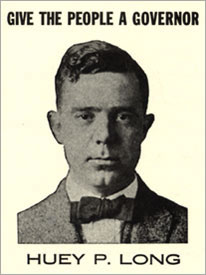Assassination of Huey Long
On September 8, 1935, United States Senator Huey P. Long was mortally wounded at the Louisiana State Capitol in Baton Rouge. He was pronounced dead at 4:10 a.m. on September 10, 31 hours after being shot. His death prevented a possible 1936 presidential bid against incumbent Franklin D. Roosevelt.
| Assassination of Huey P. Long | |
|---|---|
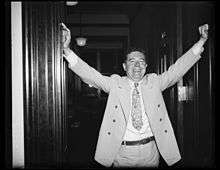 Long about two weeks before his death | |
| Location | Louisiana State Capitol, Baton Rouge, Louisiana |
| Coordinates | 30°27′26″N 91°11′15″W |
| Date | September 8, 1935 9:20 p.m. (Central Daylight Time) |
| Target | Huey P. Long |
Attack type | Political assassination |
| Weapons | FN Model 1910 |
| Deaths | Huey P. Long Carl Weiss |
| Perpetrator | Carl Weiss |
| ||
|---|---|---|
  |
||
Long was at the capitol to pass a redistricting bill which would oust Judge Pavy, opposing state judge. Shortly after passing the bill, Long was ambushed in a hallway by Carl Weiss, Pavy's son in law. Weiss shot Long in the chest. Long's bodyguards shot Weiss, killing him instantly. Although witnesses claimed that Weiss was only shot four times, an autopsy found that he had been shot at least 60 times. Long was rushed to the Our Lady of the Lake Regional Medical Center, where emergency surgery failed to stop internal bleeding.
Over 200,000 people attended Long's funeral. His remains were buried on the grounds of the Louisiana State Capitol, which he had constructed. A statue of Long by Charles Keck was erected on his grave in 1940. Without Long as its leader, his Share Our Wealth movement collapsed, clearing the way for Roosevelt to be re-elected to the White House in a land-slide.
Recent evidence has led some to claim that Long was accidentally shot by his own bodyguards. Long and Robert F. Kennedy of New York (in 1968) are the only two sitting United States Senators to be assassinated.
Life
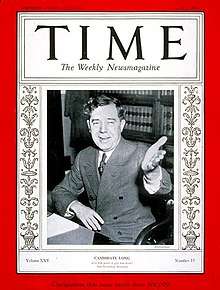
Huey Long rose to national stature in the early 1930s for his avid criticism of President Franklin D. Roosevelt and his New Deal.[1] Long proposed his own radical Share Our Wealth program, which called for massive federal spending, a wealth tax, and wealth redistribution.[2] Failing to pass legislation in the Senate, Long formed a national political organization, the Share Our Wealth Society. A network of local clubs led by national organizer Reverend Gerald L. K. Smith, the Share Our Wealth Society was intended to operate outside of and in opposition to the Democratic Party and the Roosevelt administration. By 1935, the society had over 7.5 million members in 27,000 clubs across the country. Long's Senate office received an average of 60,000 letters a week, resulting in Long hiring 48 stenographers to type responses.[3] Long's newspaper American Progress averaged a circulation of 300,000, with some issues reaching 1.5 million.[4] Long's proposals drew international attention: writer H. G. Wells traveled across the Atlantic just to interview Long. Wells noted that Long was "like a Winston Churchill who has never been at Harrow. He abounds in promises."[5]
Long had previously acknowledged the possibility of his own death.[6] Some even claimed that he had a morbid fascination with it.[3] In a 1935 speech, he claimed that his political enemies had a plot to kill him with "one man, one gun, one bullet."[7] Long had even sensationally claimed that Chicago gangsters were after him.[8] His own right-hand-man Gerald L. K. Smith declared in 1935 that "the only way they will keep Huey Long from the White House is to kill him." In spring 1935, one of the last Long opponents in Louisiana warned "I am not gifted with second sight. ... But I can see blood on the polished floor of this Capitol. For if you ride this thing through, you will travel with the white horse of death."[5]
Assassination
On Sunday morning, September 8, 1935, Long left his twelfth floor suite at the Roosevelt Hotel. While leaving, the hotel's owner Seymour Weiss[note 1] asked Long where the deduct box[note 2] was. Long replied, "I'll tell you later, Seymour." The deduct box was never found.[9] Long travelled to the State Capitol in order to pass House Bill Number One,” a re-redistricting plan, which would oust political opponent Judge Benjamin Henry Pavy.[10]
At 9:20 p.m., just after passage of the bill effectively removing Pavy, Long left the house, followed by an entourage. As he proceeded down a corridor, Pavy's son-in-law Carl Weiss stepped out from behind a column, and, according to the generally accepted version of events, fired a single shot with a handgun from four feet (1.2 m) away.[11][12] Long was struck in the torso, yelped, and ran down a hallway, "like a hit deer" one witness claimed.[11][13] Long's bodyguards, nicknamed the "Cossacks" or "skullcrushers",[11] responded by firing at Weiss with their own pistols, killing him; an autopsy found that Weiss had been shot more than sixty times by Long's bodyguards. Long was able to run down a flight of stairs and across the capitol grounds, hailing a car to take him to the Our Lady of the Lake Hospital.[7]
Long was rushed to the hospital, where an emergency surgery was held to close perforations in his intestines.[7][10] Long's condition improved within several hours and he appeared to be recovering. However, by the next morning it was realized that Long was hemorrhaging from his kidney. It was concluded that Long was too weak to survive from a second surgery.[14] Long died at 4:10 a.m. on September 10, 31 hours after being shot[15] According to different sources, his last words were either, "I wonder what will happen to my poor university boys" or "God, don't let me die. I have so much to do".[16][10] There has been controversy about whether Long could have survived with better surgical care - biographer T. Harry Williams concluded that Long died as a result of medical incompetence.[15][17] An autopsy was not conducted on Long or Weiss.[18] Alan Brinkley wrote that Long's doctors "hopelessly bungled" the operation.[19]
Perpetrator
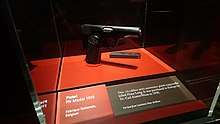
The assassin Weiss was a well respected 29 year-old ear, nose, and throat specialist from Baton Rouge. His father was president of the Louisiana Medical Society.[20] Weiss was not involved in politics and had just had a son with his wife Yvonne, the daughter of Judge Pavy.[11][7] It was rumored that Long referred to the Pavy's as having "Negro blood", possibly motivating Weiss,[21] but there is no written record of Long saying that.[20] Weiss owned a gun, which he often carried with him during house-calls, a common practice at the time.[11] Weiss' house was not searched by the authorities after the shooting and there is no evidence that he premeditated the killing.[7]
At the time, Weiss's wife and their families did not accept his guilt. Indeed, Weiss's parents indicated that he had seemed quite happy earlier on the day that Long was killed.[22]
Countertheory
Although most believe that Weiss did confront Long, some claim that he only punched Long. Nurse Jewel O’Neal was one of those who helped treat the dying Long. In a 1935 affidavit, she claimed that while treating Long's bruised lip, he told her "That's where he hit me."[20] Proponents of this theory claim that Long was caught in the cross fire as his bodyguards shot Weiss, and was hit by one of the bullets which ricocheted off the marble walls.[11][23]
Francis Grevemberg, head of the Louisiana State Police in the 1950s, claimed in an affidavit that during a 1953 gambling raid, he heard three state troopers say that bodyguards Joe Messina and Murphy Roden opened fire on Weiss after he punched Long. He also claimed that one of Long's former security guards told him that Weiss's gun was removed from his car and planted at the scene. Grevemberg claims he was told not to investigate.[15][20] Delmas Sharp Jr., the son of one of Long's bodyguards, claimed that in 1951 his father brought him to a bar owned by Messina. He stated that his father identified Messina as the man who killed Long. Messina turned his back on his colleague but did not deny the claim.[20]
In a 1986 book, Ed Reed claimed that two bullets, not one, were found in Long's body. He relied on testimony from Long's mortician, who claimed that a doctor returned late at night to remove an additional bullet from Long's corpse.[15] This was not the only discrepancy. Weiss’ brother, Tom Ed Weiss, who arrived at the scene an hour after the shooting, claimed that Weiss' car had been moved from where witnesses had seen it at the door of the Capitol and that his brother's gun had been removed from the glove compartment. Additionally, the coroner did not find car keys in Weiss's pockets.[20]
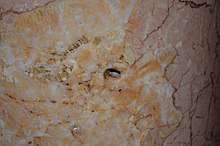
Weiss' son, Carl Weiss Jr. believed his father to be innocent: "I don't believe that he fired a fatal shot or indeed that he carried a gun into the state Capitol that night." In a 1985 conversation with Long's son Russell, Weiss learned of the existence of his father's gun. With James Starrs of George Washington University, Weiss located the gun in a New Orleans safe-deposit box, owned by Mabel Guerre Binnings, the daughter of Louis Guerre, the state's head of crime investigations in 1935. After a legal battle, she gave up possession of the box in 1991. It contained Weiss' .32 caliber automatic pistol, a .32 caliber bullet that had been fired and had a blunt tip from an impact, and photos of Long's clothing, showing a single bullet hole. After firing a test bullet, State Police investigators concluded that the bullet was not fired by Weiss' gun. However, it could not have been from one of the bodyguards as they carried a larger caliber.[15]
As Weiss was never given an autopsy, his body was exhumed in 1991.[18][24] His remains were examined at the Smithsonian Institution's Museum of Natural History. Although nearly all soft-tissue had decomposed, pathologists were able to study his damaged bones. They concluded that at least 24 bullets struck Weiss, conflicting with eyewitness accounts of at least 60. This discrepancy is likely due to most bullets passing through soft-tissue and missing Weiss' bones. They were also able to determine the angle of impact of each bullet: Weiss was shot front the front 7 times, thrice from the right, twice from the left, and 12 times from behind. This indicates that Weiss was killed in an erratic crossfire. A .38 calibre slug was found in Weiss' skull, having entered below his left eye. According to ballistics expert Lucien C. Haag, a bullet of this size should have had enough energy to exit the skull. He claimed that this lack of force was indicative of it passing through another body. It is believed that this bullet passed through Weiss' arm: suit fiber was attached to the bullet and there was damage to bones in Weiss' arms. Starrs claims that this suggests that Weiss was in a "defensive posture", with arms raised before him.[11]
After the assassination, the MONY Life Insurance Co. dispatched company investigator K. B. Ponder to validate the nature of Long's death. His 1935 report concluded:
There is no doubt that Weiss attacked Long, but there is considerable doubt that Weiss ever fired a gun. ... There is no doubt that his death was accidental, but the consensus of more informed opinion is that he was killed by his own guard and not by Weiss.[15]
In determining that Long's death was accidental, MONY paid a $20,000 life insurance claim to Long's widow. This information was only publicly released in 1985, 50 years after Long's death.[15]
Criticism
Louisiana State University professor T. Harry Williams, wrote of this theory in his Pulitzer Prize-winning 1969 biography of Long:
... no one had taken it very seriously, for unless all the witnesses to the event were lying or mistaken, only four shots had been fired while Huey was still in the corridor, the two from Weiss's pistol that struck Huey and Roden's wristwatch, respectively, and the two from the revolvers of Roden and Coleman that dropped Weiss. By the time the other guards had got their guns out and started to fire Huey had run from the scene.[25]
Aftermath and legacy
Memorial and investigations
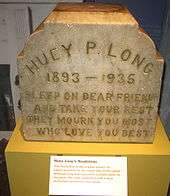
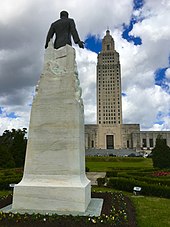
Long's body, dressed in a tuxedo, lay in an open double casket (of bronze with a glass lid) in the State Capitol rotunda. Some 200,000 people entered Baton Rouge for his funeral. Tens of thousands saw the funeral in front of the Capitol on September 12;[26] presiding was Gerald L. K. Smith, co-founder of Share Our Wealth and subsequently of the America First Party.[27][28] Long was buried on the grounds of the new State Capitol, and a statue at his grave depicts his achievements.[11] Within the Capitol, a plaque marks the site of the assassination.[7]
On September 16, 1935, an inquest was held by the state authorities. Only fervent Longites were allowed to testify, including a judge who hadn't even witnessed the shooting. No ballistic or medical evidence was examined.[20] Long's allies in the Democratic Party quickly took advantage of the situation. Insinuating that Long's assassination was part of a larger conspiracy, they labelled their opponents the "Assassination Party". They published a 50 page propaganda pamphlet: "Why Huey Long Was Killed!!" However, a federal probe found no evidence of a political conspiracy.[15] In the following gubernatorial election, pro-Long campaigners carried containers of faux blood, declaring "Here it is, like the blood Huey Long shed for you, the blood that stained the floor as it poured from his body. Are you going to vote for those who planned this deed and carried it into execution." Their chosen candidate, Oscar K. Allen, was elected in a landslide.[3]
1936 election
Long's death brought relief to the Roosevelt administration, which would go on to win in a landslide in the 1936 election. Farley publicly admitted his apprehension of campaigning against Long: "I always laughed Huey off, but I did not feel that way about him." Roosevelt's close economic advisor Rexford Tugwell would later write: "When he was gone it seemed that a beneficent peace had fallen on the land. Father Coughlin, Reno, Townsend, et al., were after all pygmies compared with Huey. He had been a major phenomenon." Tugwell also wrote that Roosevelt regarded Long's assassination as a "providential occurrence".[5]
Cultural and societal impact
Long's assassination turned him into a near legendary figure in some parts of Louisiana. In 1938, Swedish sociologist Gunnar Myrdal encountered rural children who not only insisted Long was alive, but that he was president.[29] A 1940 Gallup poll found that 55% of Lousianians viewed Long as a positive influence, while just 22% viewed him negatively.[30]
See also
Notes
References
- Williams (1981) [1969], pp. 636–39.
- Jeansonne, Glen (Autumn 1980). "Challenge to the New Deal: Huey P. Long and the Redistribution of National Wealth". Louisiana History: The Journal of the Louisiana Historical Association. 21 (4): 333. Retrieved June 17, 2020.
- Hess, Stephen (August 1966). "The Long, Long Trail". American Heritage. Archived from the original on June 21, 2020. Retrieved June 30, 2020.
- Berlet, Chip (November 1, 2000). Right-wing Populism in America: Too Close for Comfort. New York City: The Guilford Press. p. 127. ISBN 978-1572305625. Retrieved June 11, 2020.
- Leuchtenburg, William E. (Fall 1985). "FDR And The Kingfish". American Heritage. Archived from the original on June 26, 2020. Retrieved June 30, 2020.
- Brinkley (2011) [1983], p. 27.
- Scott, Robert Travis (September 5, 2010). "The enduring mystery of who killed Huey P. Long". The Times-Picayune. New Orleans. Archived from the original on June 9, 2020. Retrieved June 11, 2020.
- Kane (1971), pp. 73
- Mahne, Theodore P. (July 1, 2009). "Huey Long just one chapter of storied history of New Orleans' Roosevelt Hotel, which reopens Wednesday". The Times-Picayune. New Orleans. Archived from the original on June 16, 2020. Retrieved June 11, 2020.
- Glass, Andrew (September 8, 2017). "Huey Long assassinated, Sept. 8, 1935". Politico. Archived from the original on May 13, 2020. Retrieved June 9, 2020.
- Rensberger, Boyce (June 29, 1992). "Clues From the Grave Add Mystery to the Death of Huey Long". The Washington post. Archived from the original on May 16, 2020. Retrieved June 11, 2020.
- Brinkley (2011) [1983], p. 249.
- Brinkley (2011) [1983], p. 249.
- Brinkley (2011) [1983], p. 250.
- Scott, Robert Travis (September 8, 2010). "Controversy, mystery still surround the death of Huey P. Long". The Times-Picayune. Archived from the original on June 9, 2020. Retrieved June 9, 2020.
- Lowe (2008), p. 239.
- "Hull, Edgar". Louisiana Historical Association, A Dictionary of Louisiana Biography. Archived from the original on February 25, 2010. Retrieved February 1, 2011.
- Marcus, Frances frank (October 21, 1991). "Researchers Exhume Doctor's Grave To Resolve Part of Huey Long Legend". The New York Times. Archived from the original on August 18, 2019. Retrieved June 11, 2020.
- Brinkley (2011) [1983], p. 250.
- Alter, Jonathan (September 20, 2015). "Was Huey Long Killed by His Own Bodyguards?". The Daily Beast. Archived from the original on January 18, 2020. Retrieved June 11, 2020.
- White Jr., Lamar (April 2, 2018). "Huey P. Long wasn't assassinated". Bayou Brief. Archived from the original on June 9, 2020. Retrieved June 25, 2020.
- T. Harry Williams, Huey Long (1969), p. 868.
- Carmichael, Ellen (September 7, 2019). "The Truth about Huey Long". The National Review. Archived from the original on June 4, 2020. Retrieved June 11, 2020.
- Harrist, Ron (October 20, 1991). "Body of Huey Long's Alleged Assassin Exhumed". Associated Press. Retrieved June 16, 2020.
- Williams, p. 870.
- Rabenhorst Funeral Homes homepage
- Reed (1986).
- White (2006), p. 268.
- Kolbert, Elizabeth (June 5, 2006). "The Big Sleazy". The New Yorker. Retrieved July 21, 2020.
- Brinkley (2011) [1983], p. 29.
Works Cited
- Brinkley, Alan (2011) [1982]. Voices of Protest: Huey Long, Father Coughlin, and the Great Depression. New York: Knopf Doubleday Publishing Group. ISBN 9780307803221.
- Lowe, John, ed. (2008). Louisiana Culture from the Colonial Era to Katrina. Louisiana State University Press. ISBN 978-0807133378.
- Kane, Thomas Harnett (1941). Huey Long's Louisiana Hayride: the American Rehearsal for Dictatorship, 1928–1940. New York: William Morrow.
- Reed, Ed (1986). Requiem for a Kingfish. Baton Rouge: Award Publications.
- Trotter, Michael C. (Spring 2012). "Huey P. Long's Last Operation: When Medicine and Politics Don't Mix". The Oschner Journal.
- White, Richard D. (2006). Kingfish: The Reign of Huey P. Long. New York: Random House. ISBN 9780812973839.
- Williams, T. Harry (1981) [1969]. Huey Long. New York: Vintage Books. ISBN 978-0394747903.
